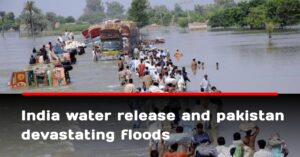In August 2025, relentless monsoon rains pushed Pakistan’s eastern Punjab into one of its worst floods in more than four decades. Buzzwrite While climate change–induced heavy rainfall played a major role, the Pakistani government also accuses India of aggravating the crisis by releasing dam water into rivers flowing into Pakistan without proper coordination or warning. Officials describe this as weaponizing water turning a natural disaster into a regional flashpoint.
Climate Change and the Role of Dams
This year Pakistan’s monsoon rainfall has been 26.5% higher than last year, particularly impacting Punjab’s agricultural heartland. To make matters worse, India reportedly opened dams on the Ravi, Chenab, and Sutlej rivers, sending torrents downstream into Pakistan. The sudden surge pushed rivers beyond their banks and submerged thousands of villages. pakistan’s Minister for Planning, Ahsan Iqbal, publicly accused India of weaponising water calling it a violation of the Indus Waters Treaty, which governs water-sharing between the two neighbors. The lack of prior warning during a season of extreme climate stress has intensified political tensions.
Humanitarian Toll : Mass Displacement and Loss of Life
The scale of destruction has been staggering. Buzzwrite There have been direct effects on over 1.2 million people, and 1,400 villages have been flooded. Over 1 million people have been evacuated to safer locations, according to some reports, and more than 800 people have died and more than 1,100 people have been injured in the flood-hit districts. Homes have been washed away, families have been torn apart, and entire farming communities have been displaced.
Government and Relief Response
The Punjab government, backed by federal authorities, has declared an emergency. Relief camps have been set up in schools, public buildings, and temporary shelters the Pakistan Army has been deployed to multiple districts—including Lahore, Faisalabad, Sialkot, Kasur, Narowal, and Sahiwal for rescue and relief operations. The National Disaster Management Authority Rescue 1122, and local NGOs are also on the ground, delivering food, clean water, and medical supplies to stranded populations. ( Apnews.com )
Health Risks and Agricultural Damage
With contaminated water spreading across towns and villages, health experts warn of a looming disease outbreak. Waterborne illnesses such as diarrhea, cholera, hepatitis, and mosquito borne fevers are on the rise the guardian meanwhile, Punjab’s fertile farmlands long considered the breadbasket of Pakistan are submerged crops of wheat, sugarcane, and rice have been destroyed, sparking fears of a food shortage and rising prices in the coming months. The damage could ripple across the economy, as agriculture remains Pakistan’s largest employer.
Looking Ahead : Lessons and Responsibilities
This disaster highlights the need for urgent reforms in water management and regional cooperation. Key takeaways include cross-border coordination : Natural disasters demand transparency and cooperation. Unannounced dam releases fuel mistrust and worsen humanitarian suffering Investment in infrastructure: Pakistan must strengthen its storage and flood-control capacity, including new dams and reservoirs to better manage monsoon surges Preparedness and resilience: Stronger early warning systems, disaster management training, and community-level awareness are essential to reduce future risks.
Conclusion
The 2025 floods in Pakistan are not just an environmental disaster but a humanitarian and political crisis. With millions displaced, crops destroyed, and lives lost, the country faces long-term consequences. The crisis has also exposed the fragility of regional cooperation between Pakistan and India neighbors tied by geography and rivers, yet divided by mistrust at a time when humanity should prevail over rivalry, both nations face a stark choice: continue the cycle of blame, or work together to prevent future catastrophes in a climate-vulnerable South Asia.






